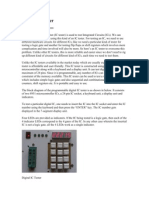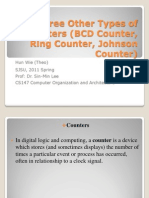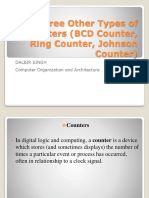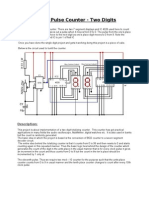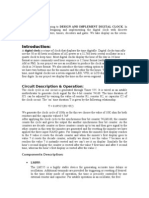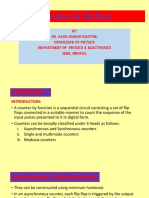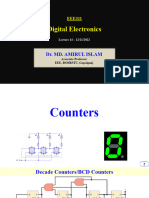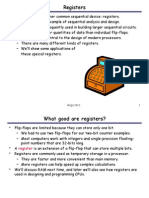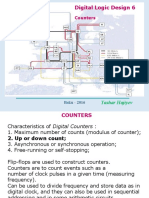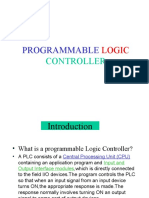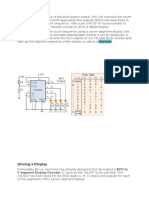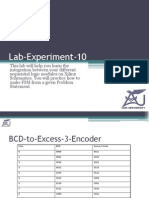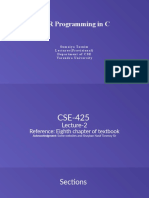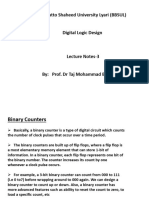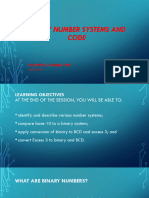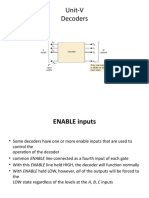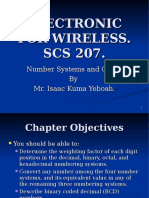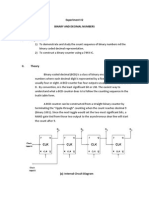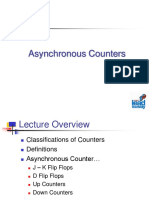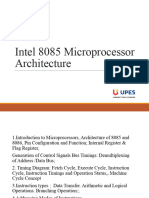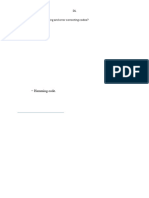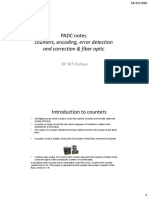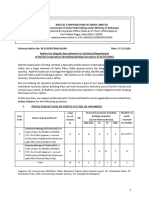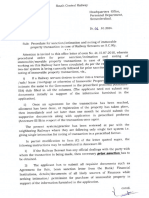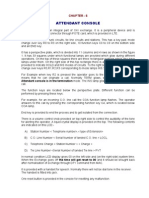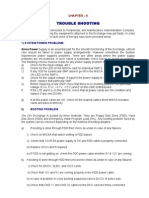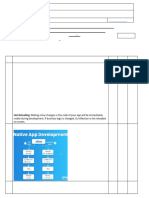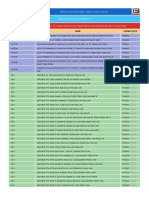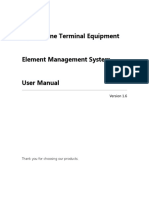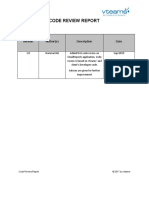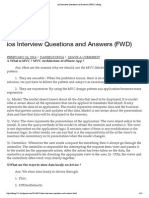Hun Wie Counter
Hun Wie Counter
Uploaded by
lvsaruCopyright:
Available Formats
Hun Wie Counter
Hun Wie Counter
Uploaded by
lvsaruOriginal Description:
Original Title
Copyright
Available Formats
Share this document
Did you find this document useful?
Is this content inappropriate?
Copyright:
Available Formats
Hun Wie Counter
Hun Wie Counter
Uploaded by
lvsaruCopyright:
Available Formats
Counters
In digital logic and computing, a counter is a device which stores (and sometimes displays) the number of times a particular event or process has occurred, often in relationship to a clock signal.
Counters(Continued)
We examine special types of addition and subtraction operations, which are used for the purpose of counting. We will show how the counter circuits can be designed using D flip-flops.
Electronic
counters
In electronics, counters can be implemented quite easily using register-type circuits such as the flipflop, and a wide variety of classifications exist:
1. Asynchronous (ripple) counter changing state bits are used as clocks to subsequent state flip-flops 2. Synchronous counter all state bits change under control of a single clock 3. Decade counter counts through ten states per stage
Electronic
counters(continued)
4. Up/down counter counts both up and down, under command of a control input 5. Ring counter formed by a shift register with feedback connection in a ring 6. Johnson counter a twisted ring counter 7. Cascaded counter
D0 D1 D2 D3
= = = =
Q0 Q1 Q2 Q3
XOR XOR XOR XOR
Enable Q0 & Enable Q1 & Q0 & Enable Q2 & Q1 & Q0 & Enable
2x1 MUX to select input, loading external when to clear, loading internal value when to count.
BCD In computing and electronic systems, binary-coded decimal (BCD) (sometimes called natural binary-coded decimal, NBCD) or, in its most common modern implementation, packed decimal, is an encoding for decimal numbers in which each digit is represented by its own binary sequence. Its main virtue is that it allows easy conversion to decimal digits for printing or display, and allows faster decimal calculations. Its drawbacks are a small increase in the complexity of circuits needed to implement mathematical operations. Uncompressed BCD is also a relatively inefficient encodingit occupies more space than a purely binary representation. In BCD, a digit is usually represented by four bits which, in general, represent the decimal digits 0 through 9. Other bit combinations are sometimes used for a sign or for other indications (e.g., error or overflow). Although uncompressed BCD is not as widely used as it once was, decimal fixed-point and floating-point are still important and continue to be used in financial, commercial, and industrial computing.
Basics for BCD To encode a decimal number using the common BCD encoding, each decimal digit is stored in a 4-bit nibble: Decimal: 0 1 2 3 4 5 6 7 8 9 BCD: 0000 0001 0010 0011 0100 0101 0110 0111 1000 1001 Thus, the BCD encoding for the number 127 would be: 0001 0010 0111 Whereas the pure binary number would be: 0111 1111
Binary-coded-decimal(BCD)
counters
Consists of two modulo-10 counters, one for each BCD digit. It is necessary to reset the four flip-flops after the count of 9 has been obtained. Thus the Load input to each stage is equal to 1 when Q3=Q0=1, which causes 0s to be loaded into the flip-flops at the next positive edge of the clock signal. Keeping the Enable signal for BCD1 low at all times except when BCD0 = 9
and BCD IBM used the terms binary-coded decimal and BCD for 6-bit alphamerics codes that represented numbers, upper-case letters and special characters. Some variation of BCD alphamerics was used in most early IBM computers, including the IBM 1620, IBM 1400 series, and non-Decimal Architecture members of the IBM 700/7000 series. Today, BCD data is still heavily used in IBM processors and databases, such as IBM DB2, mainframes, and Power6. In these products, the BCD is usually zoned BCD (as in EBCDIC or ASCII), Packed BCD (two decimal digits per byte), or "pure" BCD encoding (one decimal digit stored as BCD in the low four bits of each byte). All of these are used within hardware registers and processing units, and in software.
IBM
Ring
Counter
Ring counters are implemented using shift registers. It is essentially a circulating shift register connected so that the last flip-flop shifts its value into the first flip-flop. There is usually only a single 1 circulating in the register, as long as clock pulses are applied. (Starts 1000->0100>0010->0001 repeat)
Start control signal, which presets the left-most flip-flop to 1 and clears the others to 0.
Johnson
Counter
The Johnson counter, also known as the twisted-ring counter, is exactly the same as the ring counter except that the inverted output of the last flip-flop is connected to the input of the first flip-flop. Lets say, starts from 000, 100, 110, 111, 011 and 001, and the sequence is repeated so long as there is input pulse.
Truth Table for a 4-bit Johnson Ring Counter
Clock Pulse No 0 1 2 3 4 5 6 7
FFA FFB FFC FFD 0 1 1 1 1 0 0 0 0 0 1 1 1 1 0 0 0 0 0 1 1 1 1 0 0 0 0 0 1 1 1 1
As well as counting or rotating data around a continuous loop, ring counters can also be used to detect or recognize various patterns or number values within a set of data. By connecting simple logic gates such as the AND or the OR gates to the outputs of the flip-flops the circuit can be made to detect a set number or value. Standard 2, 3 or 4-stage Johnson ring counters can also be used to divide the frequency of the clock signal by varying their feedback connections and divide-by-3 or divide-by-5 outputs are also available.
To initialize the operation of the Johnson counter, it is necessary to reset all flip-flops, as shown in the figure. Observe that neither the Johnson nor the ring counter will generate the desired counting sequence if not initialized properly.
: Digital Logic ,Stephen Brown
Sources
http://www.doc.ic.ac.uk/~nd/surprise_96 /journal/vol4/cwl3/report.html#bcd http://people.wallawalla.edu/~curt.nelson /engr354/lecture/brown/chapter7_reg_co unters.pdf http://www.electronics-tutorials.ws
Questions?
Thank you !
You might also like
- Computer Fundamentals MCQs PDFDocument112 pagesComputer Fundamentals MCQs PDFSelvaraj Villy75% (16)
- Digital IC TesterDocument15 pagesDigital IC TesterAbhinav Choudhary100% (3)
- Three Other Types of Counters (BCD Counter, Ring Counter, Johnson Counter)Document20 pagesThree Other Types of Counters (BCD Counter, Ring Counter, Johnson Counter)deepshikhasharma230191No ratings yet
- Three Other Types of Counters (BCD Counter, Ring Counter, Johnson Counter)Document20 pagesThree Other Types of Counters (BCD Counter, Ring Counter, Johnson Counter)AtifMinhasNo ratings yet
- Digital Pulse Counter - Two Digits: DescriptionDocument7 pagesDigital Pulse Counter - Two Digits: DescriptionAsgher KhattakNo ratings yet
- Digital Assignment 2Document20 pagesDigital Assignment 2Anup PatelNo ratings yet
- Generation of ProcessorDocument35 pagesGeneration of ProcessorSanjana GawadeNo ratings yet
- Microprocessors and Assembly Language EC4121: Lecture 1: Introduction By: Mohamed Elnourani 0911471315Document27 pagesMicroprocessors and Assembly Language EC4121: Lecture 1: Introduction By: Mohamed Elnourani 0911471315divine serpentNo ratings yet
- TTL Digital ClockDocument5 pagesTTL Digital Clockyampire100% (1)
- Counters & Shifters: by Dr. Alok Kumar Rastogi Professor of Physics Department of Physics & Electronics IEHE, BhopalDocument45 pagesCounters & Shifters: by Dr. Alok Kumar Rastogi Professor of Physics Department of Physics & Electronics IEHE, BhopalKritiiNo ratings yet
- What Is Counter?: Flip-FlopDocument8 pagesWhat Is Counter?: Flip-FlopArunNo ratings yet
- RegistersDocument3 pagesRegistersPaw PaladanNo ratings yet
- DLD Question Bank For Computer ArchitectureDocument6 pagesDLD Question Bank For Computer Architecturereeshahr796No ratings yet
- Lab ManualDocument24 pagesLab ManualJaferNo ratings yet
- Unit 1 and 3-MPMC Sem4 2022Document63 pagesUnit 1 and 3-MPMC Sem4 2022OC2 Taranjeet Singh MahidwanNo ratings yet
- Eee311 L14Document18 pagesEee311 L14Saidul Islam MunnaNo ratings yet
- Counters and RegistersDocument16 pagesCounters and Registersamury kgNo ratings yet
- CH 7Document23 pagesCH 7Anonymous 7WsOWImuNo ratings yet
- Asynchronous CounterDocument5 pagesAsynchronous CounterJose GarciaNo ratings yet
- Lab 9Document6 pagesLab 9XavosNo ratings yet
- DLD Lab ManualDocument35 pagesDLD Lab ManualHrishikesh Garud100% (2)
- Code Converters, Multiplexers, and DemultiplexersDocument34 pagesCode Converters, Multiplexers, and DemultiplexersjohnsamvlbNo ratings yet
- 17 RegistersDocument20 pages17 RegistersPawan Kumar KNo ratings yet
- Digital Design 1.1Document17 pagesDigital Design 1.1harshavardhana94803No ratings yet
- CH3 + CH 4 Updated UNit 2 Addressing Methods andDocument89 pagesCH3 + CH 4 Updated UNit 2 Addressing Methods andSujan TimalsinaNo ratings yet
- Project ReportDocument44 pagesProject ReportABRAHAM UJAH50% (2)
- Digital Logic Design 6 CountersDocument37 pagesDigital Logic Design 6 CountersMurad QəhramanovNo ratings yet
- Basics of Programmable Logic ControllerDocument79 pagesBasics of Programmable Logic Controllersam_al_gino375No ratings yet
- Training ReportDocument18 pagesTraining Reportpiyushji125No ratings yet
- SW Abcd: Driving A DisplayDocument5 pagesSW Abcd: Driving A DisplayDave SedigoNo ratings yet
- Lab FSM2Document5 pagesLab FSM2Ali AhmadNo ratings yet
- ECE222 DP1 Binary MultiplierDocument8 pagesECE222 DP1 Binary Multiplierprasad357No ratings yet
- IO Port ProgrammingDocument22 pagesIO Port Programminghefawoj62No ratings yet
- Chapter 2 Micro Processor and Computer in MeasurementDocument19 pagesChapter 2 Micro Processor and Computer in MeasurementYared AssefaNo ratings yet
- Interfacing The Keyboard To 8051 Micro Controller 11Document10 pagesInterfacing The Keyboard To 8051 Micro Controller 11rajinikanth100% (1)
- Keyboard/Display Controller - Intel 8279Document16 pagesKeyboard/Display Controller - Intel 8279Anamika singhNo ratings yet
- DeltaDocument35 pagesDeltaguvendeliktasNo ratings yet
- Unit IV 8255 PIO Programmable Input Output PortDocument42 pagesUnit IV 8255 PIO Programmable Input Output Portadithya12345690% (10)
- DLD Lec3Document19 pagesDLD Lec3mf4343490No ratings yet
- Programming Programmable Logic Controllers (PLCS)Document47 pagesProgramming Programmable Logic Controllers (PLCS)eyob feshaNo ratings yet
- AngBinaryNi AntePetiDocument45 pagesAngBinaryNi AntePetiarweenmarkNo ratings yet
- Unit V - Decoders To AddersDocument36 pagesUnit V - Decoders To Adders040-NishanthNo ratings yet
- Digital ElectronicsDocument41 pagesDigital Electronicsiky77No ratings yet
- Rotary EncoderDocument6 pagesRotary EncoderalesysNo ratings yet
- Data Handling Analog Io Selection of PLCDocument14 pagesData Handling Analog Io Selection of PLCnkchandruNo ratings yet
- CounterDocument3 pagesCounterMuhammad SulemanNo ratings yet
- CMPS03 DocumentationDocument5 pagesCMPS03 DocumentationNguyễn Đức LợiNo ratings yet
- DS2020 Lab4Document8 pagesDS2020 Lab4hoi.banhphu2710No ratings yet
- Experiment - Binary and Decimal NumbersDocument6 pagesExperiment - Binary and Decimal NumbersHanna Abejo0% (1)
- Lesson 8 2 Asynchronous Counters11Document30 pagesLesson 8 2 Asynchronous Counters11Chris TineNo ratings yet
- Registers: Register Is A Group of Flip-Flops. Its Basic Function Is ToDocument20 pagesRegisters: Register Is A Group of Flip-Flops. Its Basic Function Is ToUninj XelaNo ratings yet
- Chapter 5Document50 pagesChapter 5nidz2245No ratings yet
- New Microsoft Word DocumentDocument5 pagesNew Microsoft Word Documentyashsarswat1No ratings yet
- Unit - VI DEDocument60 pagesUnit - VI DErahulbixt23No ratings yet
- 2101037Document16 pages2101037ankit.kumar21bNo ratings yet
- EEB 4202 - Slide-3A-2023Document87 pagesEEB 4202 - Slide-3A-2023Rega rastaNo ratings yet
- DL MSE NNNDocument45 pagesDL MSE NNNKIRAT PATELNo ratings yet
- Digital Electronics: Part A 20 Marks Each Carry Two MarksDocument9 pagesDigital Electronics: Part A 20 Marks Each Carry Two MarksN. A. KhanNo ratings yet
- 7 Counters PDFDocument23 pages7 Counters PDFIhuhwa Marta TauNo ratings yet
- NORMAL_Recruitment_2025_01_02T16_54_15Document8 pagesNORMAL_Recruitment_2025_01_02T16_54_15lvsaruNo ratings yet
- GRSE-14-Assistant-Project-Engineer-Notice-2024Document4 pagesGRSE-14-Assistant-Project-Engineer-Notice-2024lvsaruNo ratings yet
- TPSC-172-Specialist-Medical-Officer-Notice-2024Document7 pagesTPSC-172-Specialist-Medical-Officer-Notice-2024lvsaruNo ratings yet
- Revised Safety Officer Advt Aa Final 1Document7 pagesRevised Safety Officer Advt Aa Final 1lvsaruNo ratings yet
- Jr. Consultant (Psychologist), Advt-NRDocument4 pagesJr. Consultant (Psychologist), Advt-NRlvsaruNo ratings yet
- RailTel-Assistant-Deputy-Manager-Notice-2024Document34 pagesRailTel-Assistant-Deputy-Manager-Notice-2024lvsaruNo ratings yet
- Recruitment_vacancy-under-rseti_55d0880deaDocument7 pagesRecruitment_vacancy-under-rseti_55d0880dealvsaruNo ratings yet
- DGCA Consultant Notice 2024Document19 pagesDGCA Consultant Notice 2024lvsaruNo ratings yet
- Procedure For Sanction Intimation of Immovable Property of Railway ServantsDocument5 pagesProcedure For Sanction Intimation of Immovable Property of Railway Servantslvsaru100% (1)
- Chapter 2 SDH Basics: ObjectiveDocument10 pagesChapter 2 SDH Basics: ObjectivelvsaruNo ratings yet
- Preview-9780134393179 A26979559Document141 pagesPreview-9780134393179 A26979559lvsaruNo ratings yet
- Presentation On SDH Vs SS7Document59 pagesPresentation On SDH Vs SS7lvsaruNo ratings yet
- Advt 07Document7 pagesAdvt 07lvsaruNo ratings yet
- SPST-S&T-5 6 7Document113 pagesSPST-S&T-5 6 7lvsaruNo ratings yet
- SPST-S&T-Telecom On Indian RailwaysDocument66 pagesSPST-S&T-Telecom On Indian RailwayslvsaruNo ratings yet
- ModemDocument2 pagesModemlvsaruNo ratings yet
- Station Service Features: Chapter - 2Document7 pagesStation Service Features: Chapter - 2lvsaruNo ratings yet
- Attendant Console: Chapter - 6Document7 pagesAttendant Console: Chapter - 6lvsaruNo ratings yet
- Trouble Shooting: 1) System Power ProblemsDocument3 pagesTrouble Shooting: 1) System Power ProblemslvsaruNo ratings yet
- Oracle Cost-Based Optimizer BasicsDocument52 pagesOracle Cost-Based Optimizer BasicsSam CoolNo ratings yet
- Experis IT - Chirthani Sudheer Reddy - WASDocument6 pagesExperis IT - Chirthani Sudheer Reddy - WASLakshmi Kantha Reddy GundalaNo ratings yet
- Cia 1 QP CCS332 - App Unit 2 Answer KeyDocument16 pagesCia 1 QP CCS332 - App Unit 2 Answer KeyksathishkmNo ratings yet
- Software Engineer - Networking Applications at Intel Corporation - Stack OverflowDocument6 pagesSoftware Engineer - Networking Applications at Intel Corporation - Stack OverflowkalamkkNo ratings yet
- Minestis Users GuideDocument470 pagesMinestis Users GuideIvanRomanović100% (1)
- Dev ListDocument7 pagesDev Listsyarif4fsNo ratings yet
- Textbook Unit 4 + 5Document21 pagesTextbook Unit 4 + 5Thanh Bình ĐàoNo ratings yet
- FORM 2 HARDWARE AND DATA PROCESSING AssessmentDocument3 pagesFORM 2 HARDWARE AND DATA PROCESSING AssessmentJaylene NoelNo ratings yet
- Log DVD1Document3 pagesLog DVD1koselilloNo ratings yet
- Vmware Airwatch Advanced Remote Management Guide: Installing, Configuring, and Using The Remote Management Service V4.2Document38 pagesVmware Airwatch Advanced Remote Management Guide: Installing, Configuring, and Using The Remote Management Service V4.2Oudom ChunNo ratings yet
- A Brief Computer History PDFDocument10 pagesA Brief Computer History PDFi khanNo ratings yet
- Golang Mysql TutorialDocument3 pagesGolang Mysql TutorialReneeNo ratings yet
- PCworth Product PricelistDocument9 pagesPCworth Product Pricelistahim mahalasNo ratings yet
- Cs121 / Bacs Webmanager / Sitemanager / Sitemonitor Flash WizardDocument2 pagesCs121 / Bacs Webmanager / Sitemanager / Sitemonitor Flash WizardlucianoNo ratings yet
- CX-Supervisor: PC-based VisualisationDocument2 pagesCX-Supervisor: PC-based VisualisationThebat KhamedNo ratings yet
- LSMWDocument12 pagesLSMWDeepa SahaNo ratings yet
- Literature Review Bluetooth TechnologyDocument8 pagesLiterature Review Bluetooth Technologyafduadaza100% (1)
- Element Management System User Manual - V1.6Document227 pagesElement Management System User Manual - V1.6Murilo OliveiraNo ratings yet
- Daniel Gruss Slides Training PDFDocument249 pagesDaniel Gruss Slides Training PDFMircea PetrescuNo ratings yet
- Centum Centum VP VP HIS His Builders Builders Lesson Lesson 2 2Document22 pagesCentum Centum VP VP HIS His Builders Builders Lesson Lesson 2 2adamsNo ratings yet
- Best Practices For Load TestingDocument9 pagesBest Practices For Load Testing65bangorNo ratings yet
- Deep Sea Electronics PLC, Highfield House, Hunmanby Industrial Estate, North Yorkshire YO14 0PH, EnglandDocument256 pagesDeep Sea Electronics PLC, Highfield House, Hunmanby Industrial Estate, North Yorkshire YO14 0PH, Englandayyub_energiNo ratings yet
- Syllabus MASPTv2 PDFDocument20 pagesSyllabus MASPTv2 PDFMisbachul MunirNo ratings yet
- Code Review Report: Author(s) Description DateDocument3 pagesCode Review Report: Author(s) Description DateShahzadNo ratings yet
- JNTUH - B Tech - 2019 - 3 2 - May - R18 - EEE - 136FT PCCN Principles of Computer Communications andDocument2 pagesJNTUH - B Tech - 2019 - 3 2 - May - R18 - EEE - 136FT PCCN Principles of Computer Communications andNaga SekharNo ratings yet
- Ios Interview Questions and AnswersDocument11 pagesIos Interview Questions and AnswersRenjith Raveendran100% (2)
- Matlab CompilerDocument4 pagesMatlab CompilerAmr_HalawaNo ratings yet
- RECTGRP E0731 k170 01 7617 PDFDocument33 pagesRECTGRP E0731 k170 01 7617 PDFRamelan Ayah AlidanSyaffaNo ratings yet
- CC848836981 Pulsar Edge Product Manual r04 PDFDocument184 pagesCC848836981 Pulsar Edge Product Manual r04 PDFDiogo Faria LimaNo ratings yet

